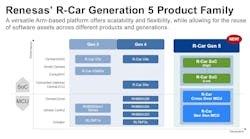For electric car (and eventually autonomous car) proliferation to occur at the anticipated levels, advances are needed to make it possible to integrate technology such as chiplets, which will give automotive engineers greater flexibility to customize their designs. For example, if more artificial-intelligence (AI) performance is required in advanced driver-assistance systems (ADAS), engineers will have the capability to integrate AI accelerators into a single chip.
To show how it intends to remove obstacles and create opportunities, Renesas Electronics has laid out plans for its next-generation systems on chips (SoCs) and microcontrollers (MCUs), targeting all major applications across the automotive digital domain. The company also provided advance information about its fifth-generation R-Car SoC for high-performance applications with in-package chiplet integration technology,
Renesas revealed two forthcoming MCU advances in the next-generation R-Car family. One is a new crossover MCU series designed to deliver the performance required for domain and zone electronic control units (ECUs) in upcoming automotive architectures. The company further announced it will introduce a separate MCU platform tailored for the vehicle control market.
A Different Software Pathway
As automotive software grows in size and complexity, the conventional approach of using hardware for software design is becoming outdated due to its lengthy production process. As a first step toward resolving this issue, Renesas is pioneering a virtual development environment for application software. It will offer advanced debugging and evaluation tools to analyze and evaluate software performance.
The company will provide these tools for next-generation processors from the first quarter of next year. As a result, developers will be able to accelerate their software development efforts even before prototypes of the next-gen devices are accessible, accelerating time-to-market.
Arguably, the toughest hurdle designers must overcome is creating the vast amounts of software required to meet user demand for increased performance and functionality. On that front, the virtual software development environment aligns with the auto industry’s move toward a shift-left approach, as this practice is widely known.
By way of perhaps an overly simplified explanation, that shift left involves integrating tasks typically performed at the end of a design process into earlier stages. It’s the practice of beginning testing and evaluating software as early in the process as possible—sometimes before the hardware is available. The primary goal of shift left is to catch and correct critical defects and errors at an earlier stage when it’s easier and faster to address them.
To ensure the design complies with the foundry’s requirements, for example, in traditional IC design flows, signoff verification occurs at the end of the design cycle. However, that also makes possible a torrent of unexpected errors when all components of an SoC are compiled into a single chip. Correcting these errors can lead to multiple rounds of time-consuming debugging and verification iterations.
Another critical task is the development of more efficient platforms that can be optimized for specific use cases.
Fifth-Generation R-Car SoCs
Until its fourth generation, the R-Car SoCs were designed for specific use cases, such as ADAS/autonomous driving that requires high AI performance, as well as gateway solutions with enhanced communication capabilities. Renesas’s fifth-generation R-Car SoC will incorporate chiplet technology to create a flexible, customizable platform that meets various requirements for each use case.
The new platform will offer multiple processor sets from entry-level to higher-end models, and can integrate a variety of IP such as AI accelerators and IP by partners and customers into a single package. This will give users the option to customize designs according to their needs.
As vehicle architectures continue to evolve, it becomes increasingly important for domain control units (DCUs) and zone control units to handle both high computing performance and real-time processing. Renesas addressed this challenge by developing an Arm-based, 32-bit crossover R-Car MCU platform with built-in non-volatile memory (NVM) that the company says can deliver higher performance than currently offered by traditional MCUs.
What’s more, Renesas is also extending its vehicle control portfolio with a new R-Car MCU series, which will be powered by Arm as well. Thus, for the first time, automotive system developers will be able to take advantage of the software and ecosystem of Arm by using these new MCUs to build powertrain, body control, chassis, and instrument cluster systems. This expansion will allow the company to standardize IP between MCUs and SoCs, increasing software usability and preserving engineering investments for its customers.
"This roadmap comes after years of collaboration and discussions with Tier-1 and OEM customers,” said Vivek Bhan, Senior Vice President, Co-General Manager of the High Performance Computing, Analog and Power Solutions Group at Renesas. “What our customers have been telling us is that they need to be able to accelerate development without compromising quality. This means they must design and verify their software even before hardware arrives. We will help them realize this goal by continuing to invest in shift-left and software-first innovations, deploying new scalable embedded processors, and bolstering our vast network of development tools.”

